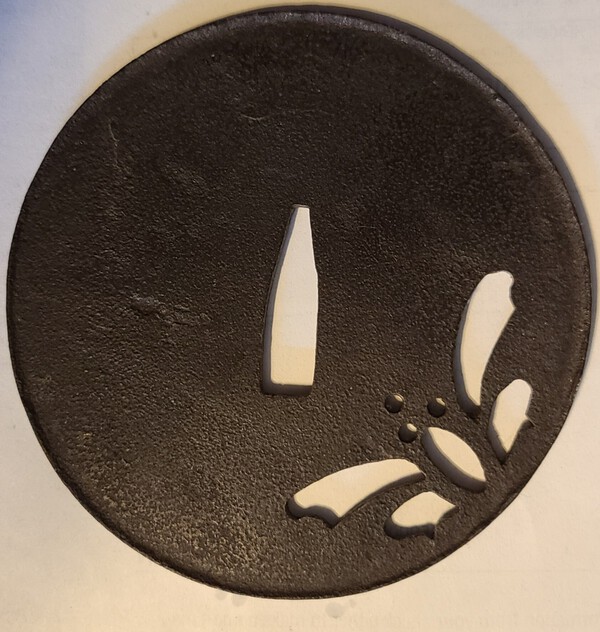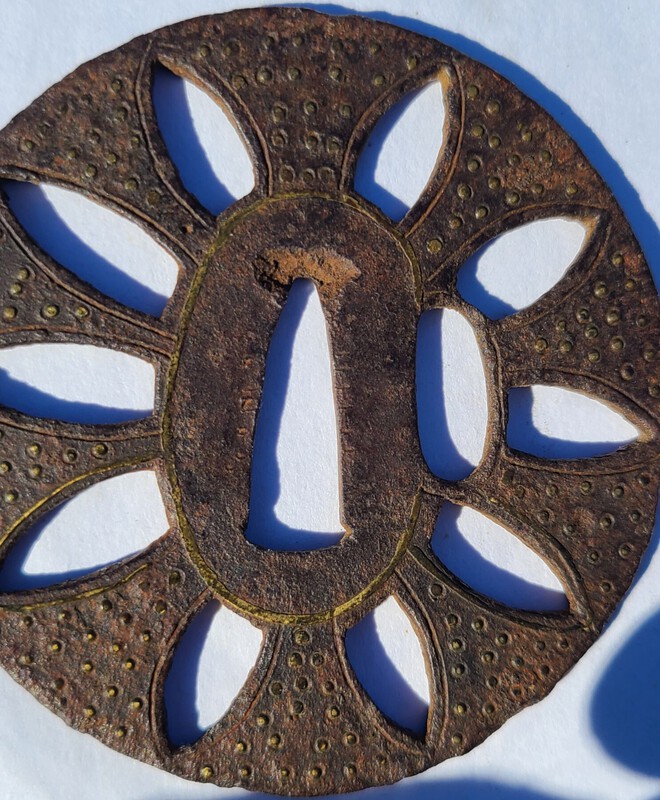
jct3602
Members-
Posts
171 -
Joined
-
Last visited
Everything posted by jct3602
-
Looks like a fairly well done copy of goto work. Appears to be thin gold, with pitch? on underside not yet cleaned, although some bright spots show through (at least to Michael Bell and I). Weight for pair at present 3.753 grams. Dimensions 2.76x1.46x.47 cm each. Any thoughts as to origin/maker and/or school would be appreciated. Part of a ko-wakizashi or O-tanto koshirae; fuchi/kashira is at least one level better than the menuki; habaki, kurikata, and saya lacquer comparable. Tsuka wrap new but poorly done and not an appropriate quality or color of silk. Same ok; small nodules, multiple pieces, but an impressive emperor node. Tsuba appears to be far older than the rest of the koshirae; iron tanto syle tsuba with nunome zogan gold inlay, even on outside of rim, very worn. I have no idea what the symbols? in gold are. Will present rest of the koshirae as I take decent photos and do careful disassembly; the menuki came out quickly because the wrap had to go. Kashira is separated, but the habaki, tsuba, fuchi, and saya are still all tightly stuck together. Thank you, John Twineham
-
Laser cut and sandcasting seems very likely (also, upon inspection, lack of oxidation in middle of interior surfaces of cuts); on opposite surface there is a little fuchi wear, but not enough for any real age. For 9,050 yen before fees, worth it for study. Thickness might also indicate very young; the Edo period tosho and katchushi tsuba were all thicker. Wonder if in that era the common .5 cm thicknesses was the result of buying factory produced iron/steel plate, then working it. Thanks to all of the responders; Happy New Year! John Twineham
-
Follow-up picture of alteration. Full tsuba on side with the one alteration is over 3mb. John Twineham
-
Thought you might like the following - 17 petal, with the upper one on one side altered from 17 to 18 petals. The theory my teacher had was this was an Imperial reward to Mori Motonari, who financed the Imperial ascension ceremonies around 1560, and the one mon altered to 18 petals was to show no assumption of imperial dignities or ongoing rights to use the imperial mon which was granted by the Emperor he aided. That alteration, 2 petals removed and 3 inserted, was certainly done after the original creation of the tsuba. Markus Sesko says that the 17 petal was an urba legend. Unfortunately, the reverse side was too large, so I will try to diminish it, or at least the altered portion, in a follow up.
-
Just received nice tsuba with sukashi butterfly motif through JAUCE. 8 cm diameter, .336 cm rim, .263 interior, listed as 90 grams. Rim very thin, but protrudes evenly on both sides above the interior thickness. Condition looks too good for an old piece (possibly even younger then Meiji), but it is thinner than I would expect for a post Koto katchushi tsuba. Has some spots where you can finger roll what looks like lacquer (probably just stickum from a price tag, lol). Question is whether during Meiji did they revert to reproductions that were closer in thickness to pre Edo pieces? Also, the presence of 3 dots for antenna, etc. rather than 2 seems to fit younger pieces, although I have seen a picture of one supposedly early ko-tosho with 3 dots. Educational input welcome! John Twineham
-
Just acquired a pair of large menuki (5.8 x 1.7 x .25 cm) on a Higo style tsuka; would appreciate any opinions as far as origin, etc. They appear to be mercury/gold amalgam on a fairly pale shibuichi; level of detail leads my thoughts to production after the introduction of Dutch optics. Apologies for the difference in lighting of the photos. Opinions/comments/thoughts welcome. John Twineham
-
-
Would appreciate translation assistance; appears to be a collector's opinion. Yours, John C. Twineham
-
Just curious as to thoughts about period, since so many heianjo-ish tsuba were produced. this one came cheaply; the seller's picture made it look bad. With some careful cleaning by a friend of mine, much improvement, and the inferior looking side actually is better now than the one the seller choose to display. Small picture before, the other 2 as is now. 7.14x7.14 cm; .41 rim, .38 seppa thickness. john twineham
-
Thanks Curran - I did not have anything to link the carving to, and that was puzzling me, so I think you are right. Have not seen enough examples of Akasaka to know how prevalent carving is. john
-
-
8.01x7.65x.69 cm and 7.56x7.12x.58 cm. the DAI is feels about 30% heavier than the SHO.
-
I apologize for not thanking all the responders earlier! My bad; got distracted and forgot (old age) about this post (and the lead up and follow up to SF tokenkai). As atonement, another daisho, put together at that show. Noticed one on a table and realized I had looked at something like it very recently on JAUCE, so picked it up and lucked out on the other. Interesting that the sort of necesary small differences involve one with chisel marks arcing clockwise, the other one has them going counterclockwise. john
-
Thanks Ford: I agree; something with real age and made with uniformity of metal, consistent patina, and little or no corrosion would seem impossible; modern metal with an interesting patination process could easily be the case, so Occam's Razor rules. Would appreciate your opinion on the following if you would; Edo? pictures taken outdoors in sunlight. Yours, John
-
Very good point Grey, and one that I had wondered about. As an alternative, if you look at the depression opposite the kozuka hitsu, it looks like the piece was hammered thinner, possibly to spread out and thus compress the nakago hitsu. Since it is only .2 cm thick, perhaps the feeling was that chiselling divots in would not do very much and be risky, the same with copper inserts that might get easily dislodged. Just a random thought. Michael Bell says that the depression was certainly an intentional hammer stroke, not a bruise. Thanks again! John
-
Thank you both! You may be quite correct. I was suspicious, but not about waxing, more about a really good late period patinating solution; the reason why I tried to give a shot that showed some of the wall of the sukashi cuts was with that thought in mind. I just left a message with Michael Bell, who primarily makes swords but also tsuba, etc., and asked about the waxing. He and his lead apprentice both have seen the item in hand, and did not mention wax, but I did not ask. They both did say it had a wonderful patina. I have 2 more available resources to show it to who might have some thoughts; one will be next weekend (Stephen Strauch), so will fill you in when I get Michael's response, and later when Stephen sees it in hand. Once again, thank you. john twineham
-
-
I like this piece, but the patina just seems ???. Although it is wet looking under the right light from an angle, and under 20x magnification the patina is a very dark brown, it seems too uniform. Would appreciate feedback. dimensions are 8.2x8.1 cm but the thickness is very irregular; rim varies from .354 to .175 cm and the area around the nakago hitsu .27 to .32 cm. Will send pictures in 2 batches and try to show the interior walls of the sukashi. All pictures taken inside but indirect exterior light. Thanks, john twineham
-
A friend bought this since it was way too expensive for me! But I directed him to it after I looked at it.. The surface is wild. john twineham
-
Hi Jean: I looked up the same entry in the Varshavsky collection that you referenced; originally it was what gave me hope the piece is genuine. Fortunately, as long as the piece pleases the collector, real or fake really only matters when their estate is being auctioned off after their demise, lol. Also have another tsuba that I got from the same seller on JAUCE that I like far better, but it will spark controversy, ridicule, appreciation, or some combination of the 3 on this board, so i am hesitant to present it. If there is some way I can send you the pictures, I would appreciate your opinion of whether I have departed sanity or not (I am unfamiliar with the mechanics on the board to send single person communications). It does have the best patina of any piece I have acquired or held in hand; truly wet like the surface of a glistening black pond when well lit. Interesting how patina looks like under 20x magnification; what looks black is a light absorbing black brown rust, and the look of wetness is from tiny specks of reflective iron/steel peeking through the rust, like nie on a blade. Once again, thank you! John Twineham
-
The bright brass was when the tsuba was angled towards sun; the dim was taken indoors. Took more pictures, but my computer occasionally insists I have insufficient memory when I download pictures that i emailed to myself from my cellphone, and will not display them. In any event, I like this one; it would really be nice if it is not just a later period copy of an onin tsuba, so commentary either way will be welcome. 7.7x7.6 cm, .33 cm thick rim and .25 cm thick in the seppadai. John Twineham
-
beware seller sengoku_54jp
jct3602 replied to lonely panet's topic in Auctions and Online Sales or Sellers
Contacted JAUCE about this; it is perfectly acceptable as far as they are concerned. The problem (I think) is private deals can occur with large volume bidders; lets say you have a limit bid of 25,000 yen, but the auction only goes to 16,000 yen (and you are leading bidder). The dealer knows another dealer who will pay the price he wants, 20,000 yen. Piece is pulled, deal is made, and since JAUCE can not legally divulge a bidders maximum offer, your willingness to pay 25,000 yen does not get you the item. JAUCE says the reason is that they do not allow "reserve" prices, so anytime you see an item at 1, 100, 1,000 yen as a starting price (to encourage auction fever), be aware that the if the final price is "too good to be true", it will be pulled. The only dealers that do not do this either start with a high initial auction price, or have an even higher initial auction price and a BIN price. Have run into this on at least 4 occasions in the last 4 months where I was highest bidder; one time I bid 14,503 yen; the dealer pulled and relisted it on his site with a starting bid of 144, 999 yen at end of auction. John T. -
Perhaps a different slant on the tsuba at the 1972 Dallas show. My teacher, Blaine Navroth, was there and remembers additional information. After the fake tsuba were papered, the comments about production were made, and, according to Blaine the creator (perpetrator?) presented some authentic Muromachi period tsuba to the shinsa; the shinsa then papered them all as late EDO; what goes around comes around. Perhaps this is poorly recollected by him after 50 years, but still an interesting alternate story. john twineham
-
Thoughts on origin? Two small files are from sale pictures; other is in hand in natural sunlight; attempted to crop but for some reason the program would not show the cropped pictures. Will send reverse side in following. john





.thumb.jpg.f837a5fe1adbe1e079becd5ba7e8aa07.jpg)

.thumb.jpg.5c2274be950b750465c32a8972ee7c19.jpg)
































